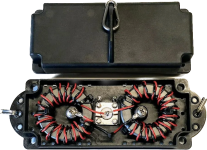It comes with an efficient 4:1 current balun
because it requires one. It will not match 50Ohm coax otherwise. Notice I used the word "directly."
Finding the exactly ideal feed point is very difficult to do
at home. With a commercial model this is already done for you. Covering wider bands such as 80M generally requires a mixture of impedances above and below ideal. As long as they're within practical limits it's all good.
12M is easy with a fractional bandwidth of only .4. But 80M is difficult to cover with any antenna type having a fractional bandwidth of 13.3. Generally you get one end or the other including the OCFD. 17M rarely matches well.
4:1 will often be a voltage balun. The so-called 4:1 Guanella balun attempts to avoid transformer action by placing 2 coils in parallel. They can be efficient when using 2 cores because symmetric signals can pass through them with little loss instead of going in to the core, clever. But the common mode impedance is half of a simple 1:1 current balun.
A 1:1 choke balun is a current balun and this is required because it's an unbalanced antenna and you'll have common mode current on the feedline without it.
Depending on which side you're looking at, input versus output for transmitting or receiving, the 4:1 Guanella makes a transformation of double the voltage and half the current. It uses windings to induce current. This is transformer action and therefore describes a voltage balun. However, a goal is to produce equal voltages on the balanced terminals therefore describing a current balun. It's a strange critter.



